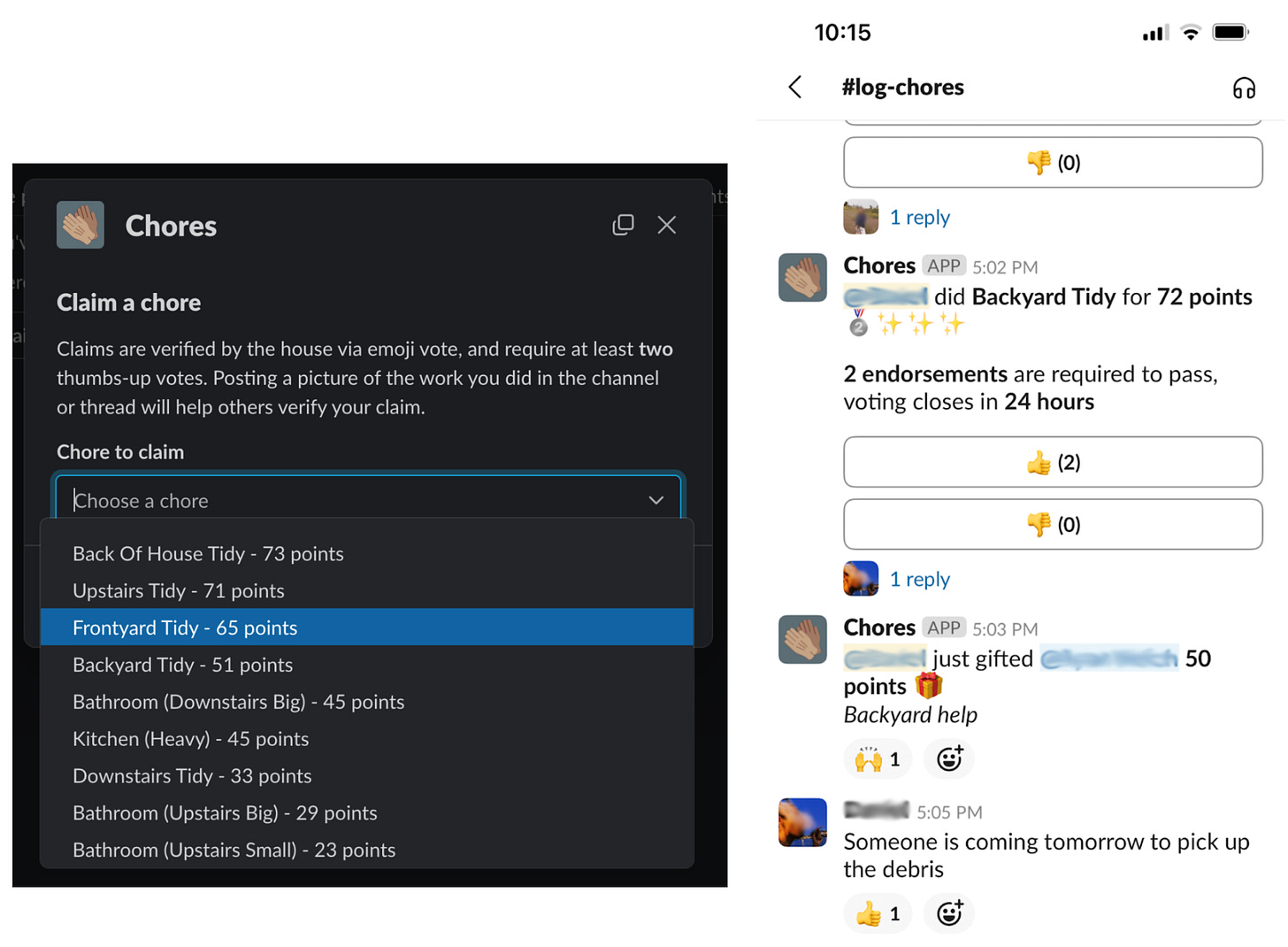Editor’s note: this is a guest post from Daniel Kronovet, founder and past resident of Sage House, one of a planned series of community houses from Zaratan. A common fear people have about community living is that they’ll be stuck in endless house meetings. Sage House shows how this doesn’t have to be true, thanks to some novel Slack apps informed by the founders’ background in governance.
This is part of an ongoing series of deep dives on coliving spaces. To see others, visit the Supernuclear directory.
Name: Sage House
Date founded: September 2022
Location: Highland Park, Los Angeles
Rented or owned: Hybrid model: housemates rent from past-resident founder-owner who provides limited operational support
Amount of space (number of beds/baths, any notable amenities): 9 bed / 4 bath / gym / recording studio / backyard fire pit
Governance: Lazy consensus / do-ocracy with the help of custom Slack apps
Origins: Sage House is the pilot house for a type of "coliving for busy people" -- making communal living accessible to folks who don't have deep community experience, who are looking for a social and affordable place to live while pursuing personal goals, and who don't want to spend much time or energy keeping the house running. The founders have a background in governance and computer science, and developed Slack apps to support collective decision-making without relying on house managers or excessive meetings. The house itself, a 1905 Craftsman, was purchased in July 2020 and renovated over two years during the pandemic, adding three bedrooms and a restaurant-style kitchen.
Inner workings
All formal decisions take place asynchronously over Slack, with the aid of custom apps which handle things like chores, behavioral issues, and bulk purchasing, with part of rent going into a shared account. Once-monthly "house circle" meetings allow for informal discussion and consensus-building, creating a hybrid offline/online governance system. The structure is very effective, with housemates doing an average of 2-3 hours of chores per month and sitting in meetings for only 1-2 hours per month. There is no house manager, and any housemate is empowered to do anything at any time, with most communication happening over Slack. The chore system is so effective that the house does not hire cleaners, leaving more funds available for food and other discretionary purchases.
The apps are currently in beta but will be released publicly later this year. If you are interested in trying them at your own house, you can sign up for updates here.
Zaratan’s three Slack apps to manage house governance: Things, Chores, and Hearts
Lessons learned
A big influence on the structure of the house came from the work of Elinor Ostrom, the Nobel-winning economist who did extensive research on communal management of shared resources. One pillar of her research was the importance of letting participants establish their own rules and structures. This need for engagement created some early tensions as the founders had deep experience in communal living, but most new housemates had relatively little experience. Meaningfully incorporating housemates in questions of governance required finesse, incorporating their feedback and opinions when possible (returning surplus food budget as rent credits) but also being empathetic but firm when not possible (changes which could undermine the fairness of the chore system). Fortunately, much of that discovery process was one-off, and after operating for a year the structures and systems have matured to the point where these frictions are non-existent or easily resolvable.
The chore management system in action. Gillian’s note: I especially like the ability to gift points to people who help you with a chore.
A second tension involved the role of one of the founders who spent the first year living in the house. A core value at Sage is "no managers, no meetings" and so the founder made efforts to model leadership via soft power, building consensus and leading by example. At one point halfway through the year it became necessary to do some construction on the lot, which brought to the surface the harder power relations which had been mostly kept in the background, as residents found that they could not simply vote to limit construction. This lack of agency created some resentment between other housemates and the founder, as the housemates felt that it wasn't really "their space". Ultimately the tension was resolved by the founder stepping back from day-to-day involvement and ultimately moving out (to live with a partner), allowing the housemates to experience more genuine autonomy and agency in the house.
The living room with a view into the dining room at Sage House.
A broader lesson learned is that there is demand for Sage House’s "structured semi-intentional" community, as to-date all recruitment has been by word-of-mouth. One of the founders was exposed to communal living through the Berkeley Student Cooperative, and was specifically struck by the way that well-established structures and processes can allow people without prior communal living experience to enter into and thrive in a communal setting, choosing their level of engagement as circumstances permit.
Further, the population of people willing to pay rent to flexibly live in community is much larger than the population of people able to commit the time and money needed to start a community from scratch. With the right structures in place, people who are looking for quality, affordable housing can easily enter into a communal setting and enjoy a very high quality of life.
Curious about coliving? Find more case studies, how tos, and reflections at Supernuclear: a guide to coliving. Sign up to be notified as future articles are published here:
No spam, just the good stuff.
You can find the directory of the articles we’ve written and plan to write here.












Thanks @daniel for the case study!
Really interesting Slack tools - and really wonderful comments in this section here.